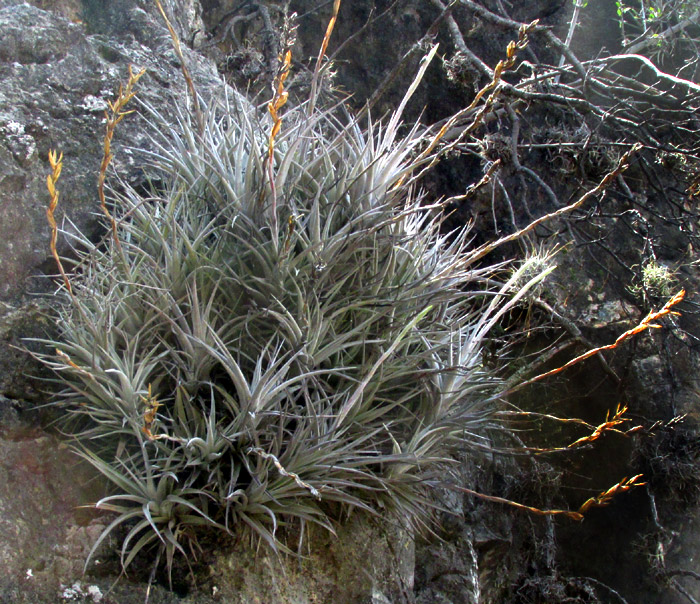Excerpts from Jim Conrad's
Naturalist Newsletter
Entry dated March 9, 2024, from notes taken about 2kms west of Higuerillas, Municipality of Cadereyta de Montes; N20.9086°, W99.7865°, elevation ~1760 meters (~5760 feet); on greywacke sandstone cap of hill; area constituting a narrow belt of the extreme southern extension of the Chihuahuan Desert, Meridional Subregion; central Querétaro state, MÉXICO
TILLANDSIA KARWINSKYANA

Clinging to a sandstone rock face, the above bromeliad was doing well despite the North American Drought Monitor characterizing our continuing, two-year-long dry period as an extreme drought. Bromeliads, members of the big Bromelia Family, the Bromeliaceae, can be hard to identify, especially when their flowering season is long passed, as with this one. Currently the family comprises about 76 genera and some 3700 species, native mainly to tropical America. They're monocots, like orchids, lilies and grasses, not dicots like most other flowering plants; pineapple plants are bromeliads.
In 2018, Adolfo Espejo-Serna and Ana Rosa López-Ferrari in their "La familia Bromeliaceae en México," reported that Mexico is home to 422 bromeliad species, separated into eight genera. Over half of those taxa belong to the single genus Tillandsia, including about 230 species. Often all Tillandsia species are known as air plants.
In our part of upland central Mexico known as the Bajío, you know that the above bromeliad is a Tillandsia because the blade margins bear no teeth or spines, the flowers arise directly from the main flowering stem, the rachis, without a pedicel, and the plants grow in a large, crowded bunch, not singly or with only a few sprouts. The 2010 edition of theFlora del Bajío reports 31 Tillandsia species here.
The best field marks shown above for identifying which Tillandsia species we have is that our colony of numerous plants is growing from a rock face; it's not growing epiphytically on a tree, as by far most Tillandsia species do, and doesn't consist of just one or a few plants. Another field mark is that the inflorescences stand atop upward-directed peduncles, not dangling ones, and the inflorescences are not nested among the blades. Also, the leaves clearly are wider than 5mm across (0.2inch)

Furthermore, above it's seen that the flowers grow so closely together that the rachis isn't seen. The scale-like bracts subtending each developing fruit capsule is broad and scoop-shaped, and, as seen below, conspicuously lined with parallel veins:

Above, the blackish, dried-up items are flower remnants, each arising askew atop a capsular-type fruit maturing behind the bract below it. Photos show that when flowering the bracts were pink with many scattered, tiny, white dots; they're "lepidote." Apparently the white dots survive on the dried scales as tiny brown dots. The fresh flowers' greenish yellow color combined attractively with the pink bracts.
Because so many Tillandsia species found in our area similar to this one that I may not have able to identify it, except for our plant's single big distinction: It grows on a rock face. In our area, only a few Tillandsia species might grow on a rock outcrop, and pictures of those species show features of body and inflorescence structure which disqualify them. The single species matching all details shown by our plants is TILLANDSIA KARWINSKYANA.
Tillandsia karwinskyana, bearing no English name, is endemic just to Mexico. It grows on rocks and the ground in submontane scrub and succulent-dominated environments from Mexico's northeastern Nuevo León state, south to here in central Querétaro and just across the border in Hidalgo state. The Flora del Bajío describes the species as not particularly abundant but also not threatened with extinction in our area.
The 2011 publication by Demetria Martha Mondragón Chaparro and others entitled La familia Bromeliaceae en México notes that Tillandsia karwinskyana is used by humans as food, medicinally, and as ornamentation during Christmas and other occasions; there's no mention of how it's eaten or used medicinally. Often country folks feed various bromeliad species to livestock, as they do the agaves.
The garden-oriented TropiFlora.Com website describes Tillandsia karwinskyana as a good species for mounting in containers hung on walls. It's very prolific, they say, and will form a nice clump in a relatively short time. Also, it's easy to grow with no special care, in general needing plenty of light, and soil kept on the dry side. That site sells a single plant for US $25.00.
The species was named in honor of Wilhelm Friedrich Karwinsky von Karwin (1780-1855), who was a Bavarian naturalist who collected plants and animals in Mexico and Brazil. We've met with a genus named for him, Karwinskia humboldtiana, the Humboldt Coyotilla, plus there are many species of both plants and animals bearing his name. Our Tillandsia karwinskyana was introduced to science by one of his collections dated 1830, taken somewhere in Mexico called -- as are many out-of-the-way places in Mexico -- La Escondida, meaning "the hidden place."